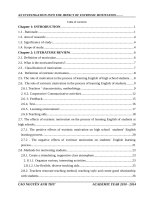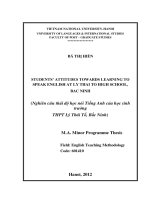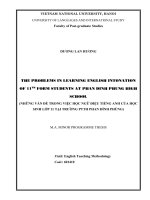Demotivation in learning english of the students of ly thai to high school in bac ninh
Bạn đang xem bản rút gọn của tài liệu. Xem và tải ngay bản đầy đủ của tài liệu tại đây (942.72 KB, 19 trang )
VIETNAM NATIONAL UNIVERSITY, HANOI
UNIVERSITY OF LANGUAGES AND INTERNATIONAL STUDIES
DEPARTMENT OF POST- GRADUATE STUDIES
VŨ THỊ HUYỀN
DEMOTIVATION IN LEARNING ENGLISH OF THE
STUDENTS AT LY THAI TO HIGH SCHOOL IN BAC NINH
(SỰ MẤT HỨNG THÚ HỌC TIẾNG ANH CỦA HỌC SINH
TRƯỜNG THPT LÝ THÁI TỔ, BẮC NINH)
PROGRAM I
M.A.MINOR THESIS
Field: English Teaching Methodology
Code: 60 14 10
HANOI, 2011
VIETNAM NATIONAL UNIVERSITY, HANOI
UNIVERSITY OF LANGUAGES AND INTERNATIONAL STUDIES
DEPARTMENT OF POST- GRADUATE STUDIES
VŨ THỊ HUYỀN
DEMOTIVATION IN LEARNING ENGLISH OF THE
STUDENTS AT LY THAI TO HIGH SCHOOL IN BAC NINH
(SỰ MẤT HỨNG THÚ HỌC TIẾNG ANH CỦA HỌC SINH
TRƯỜNG THPT LÝ THÁI TỔ, BẮC NINH)
M.A.MINOR THESIS
Field: English Teaching Methodology
Code: 60 14 10
Supervisor: Trần Hiền Lan, M.A.
HANOI, 2011
iii
ABSTRACTS
This study was aimed at investigating de-motivating factors in learning English
of the students at Ly Thai To High School in Bac Ninh, the degree of influence of
different de-motives on them and their experiences in overcoming de-motivation in
learning English. The sample of study consisted of 100 students at Ly Thai To High
School in Bac Ninh and the instrument of the study was a questionnaire on finding
their foreign language learning experiences. These findings indicated that their demotivation in learning English was a significant issue for EFL learning, and a
framework for discussing the different sources of de-motives was developed. While
some categories of de-motives occurred more frequent than others, no category
appeared to be more or less difficult to overcome. Rather these, students’ awareness of
the role of English language and their determination to succeed were critical factors in
overcoming their de-motivation in learning English.
iv
TABLE OF CONTENTS
Certification of originality of project report
i
Acknowledgements
ii
Abstract
iii
Table of contents
iv
List of abbreviations
vi
List of tables
vii
Part A: Introduction
1
1. Rationale
1
2. Aims of the study
2
3. Research questions
3
4. Scope of the study
3
5. Methodology
3
Part B: Development
4
Chapter 1: Literature review
4
1.1. Second language acquisition
4
1.1.1. What is “second language acquisition?”
4
1.1.2. What are the goals of SLA?
5
1.2. Theoretical background of motivation
6
1.2.1. Conceptions of motivation
6
1.2.2. Motivation in foreign language learning
7
1.3. Theoretical background of de-motivation
12
1.3.1. Conceptions of de-motivation
12
v
1.3.2. De-motivating factors affecting students’ motivation in learning
foreign languages
13
13
1.3.2.1.
Factors related to students
15
1.3.2.2.
Factors related to environment
16
1.3.2.3.
Factors related to teachers
18
1.3.2.4.
Teaching and learning conditions
19
1.4. Study of de-motivation
24
1.5. Summary
24
Chapter 2: Research methodology
24
2.1. Research questions
24
2.2. Subjects
25
2.3 Method for data collection
26
Chapter 3: Results and discussion
26
3.1. Results
26
3.1.1. Results of research question 1
27
3.1.2. Results of research question 2
29
3.1.3. Results of research question 3
30
3.2. Discussion
33
Part C: Conclusion and implications for teaching
37
1. Conclusion
37
2. Implications for teaching
37
3. Limitations and further study
39
References
40
Appendix
I
vi
LIST OF ABBREVIATIONS
SLA: Second Language Acquisition
EFL: English as a Foreign Language
FL:
Foreign Language
L1:
First Language
L2:
Second Language
NNS: Non-Native Speaking
vii
LIST OF TABLES
Table 1: Dornyei’s (1994) framework of L2 motivation (Adapted from Dornyei, 2001)
Table 2: William and Burden’s (1997) framework of L2 motivation
Table 3: External de-motivating factors
Table 4: Internal de-motivating factors
Table 5: Internal reasons for overcoming de-motivation
Table 6: External reasons for overcoming de-motivation
1
PART A: INTRODUCTION
1. Rationale.
- Motivation is one of the main factors determining an individual’s success in learning
a second or foreign language.
- As English has become more and more important as an international language in most
countries around the world, large numbers of students are being required to learn it
through compulsory programs at schools and universities.
- Despite the current extrinsic pressures to learning English as a foreign language in
Vietnam, many students do not seem to have interest in learning English, or in other
words, they are quite de-motivated.
2. Aims of the study.
The study aims at:
- Investigating the factors that cause a negative impact on learning English of the
students at Ly Thai To High School in Bac Ninh based on the study of 100 students of
grade 12.
- Giving suggestions and recommendations to teachers at Ly Thai To school.
3. Research questions.
Question 1: What are the external factors that cause a negative impact on students’
motivation to learn English?
Question 2: What are the internal factors that cause a negative impact on students’
motivation to learn English?
Question 3: What solutions can help students to overcome their de-motivation?
4. Scope of the study.
In terms of scope of the study, I investigated 100 students in grade 12 about the
factors which de-motivated them to learn English and reasons that can help them to
overcome their de-motivation (by asking them to answer the questionnaire).
5. Methodology.
The method applied in this study is both quantitative and qualitative. The data
which this study drew on come from questionnaire (closed-items and open-items) of
100 students who are in grade 12 at Ly Thai To High School in Bac Ninh.
2
PART B: DEVELOPMENT
CHAPTER 1: LITERATURE REVIEW
1.1 Second language acquisition:
“Language acquisition is one of the most impressive and fascinating aspects of
human development” (Lightbrown, P.M & Spada, N. 1999). Up to now, there have
been many definitions of language acquisition. This term is most often used
interchangeable with language learning. In their study, they show that according to
Krashen, S. (1982), acquisition represents “unconscious” learning, which takes place
when attention is focused on meaning rather than language form.
1.2 Theoretical background of motivation
Burden, (1997:119) assumed that “from a cognitive perspective, motivation is
concerned with such issues as why people decide to act in certain ways and what
factors influence the choice they make. It also involves decisions as to the amount of
effect people are prepared to expand in attempting to achieve their goals. The role of
the teacher thus becomes one of helping and enabling learners to make suitable
decisions”.
Dornyei (2001:613) defined motivation as “a general ways of referring to the
antecedents (i.e. the causes and the origins”. He also stated that “motivation explains
why people decide to do something, how hard they are going to pursue it and how long
they are willing to sustain the activities” (2001:7). The author mentioned two
dimensions of human behavior: direction and magnitude (intensity) which motivation
concerns.
1.3 Theoretical background of de-motivation:
Dornyei (2005:143) defined de-motivation as “specific external forces that
reduce or diminish the motivational basis of a behavioral intention or an ongoing
action”.
3
Dornyei pointed out that de-motivation does not mean that all the positive
influences that originally made up the motivational basis of a behavior have been got
rid of. It only means that a strong negative factor restrains the present motivation with
some other positive motives still remain ready to be activated.
Qashoa (2006:2) has reported from Domyei (2001) that, “ A de-motivated
person is someone who initially had a motivation to fulfill a goal or to engage in an
activity and has lost the motivation to do so because of negative external factors which
are related to the environment in which learning takes place such as the classroom or
school”.
4
CHAPTER 2: RESULTS AND DISCUSSION
2.1 Results
2.1.1 Results of research question 1
Q1: What are the external factors that cause a negative impact on students’ motivation
to learn English?
Table 3: External de-motivating factors
Rank
1.
2.
3.
4.
De-motivating factors
Lack of opportunities to use English outside class
Examination system (have to concentrate on main
subjects for college entrance exams)
Teaching method (uncreative, boring)
Lack of opportunities to speak English in class
because the classroom is too crowded
Frequency Percentage
79
79 %
78
78 %
58
58 %
37
37 %
5.
Availability of instruction books
29
29 %
6.
Insufficient teaching and learning facilities
27
27 %
7.
Teachers’ unfair behavior
24
24 %
8.
Replace teachers from the better to the worse
21
21 %
9.
Test outside lessons
18
18 %
10. Teachers’ competence (low credibility)
17
17 %
11. Lack of teachers’ care and enthusiasm
16
16 %
12. Teachers insult students
14
14 %
2.1.2 Results of research question 2
Q2: What are the internal factors that cause a negative impact on students’ motivation
to learn English?
5
Table 4: Internal de-motivating factors
Rank
De-motivating factors
Frequency Percentage
1.
Large vocabulary
71
71 %
2.
Listening and speaking skill difficulties
70
70 %
3.
Complicated grammar
53
53 %
4.
Fail to understand lesson (lost background knowledge)
48
48 %
5.
Difficult pronunciation
43
43 %
6.
Unconfident (afraid of being laughed/ losing face)
38
38 %
7.
Left behind classmates
35
35 %
8.
Think themselves do not have aptitude
28
28 %
9.
Get low marks despite having studies seriously
12
12 %
10.
Feel disregarded by teachers and classmates
10
10 %
2.1.3 Results of research question 3
Q3. What reasons can help students to overcome their de-motivation?
Table 5: Internal reasons for overcoming de-motivation
Rank
Reasons
Frequency Percentage
1.
Awareness of the importance of English
50
50 %
2.
Self-determination
43
43 %
3.
Get progress and like English more
41
41 %
29
29 %
25
25 %
22
22 %
20
20 %
18
18 %
4.
5.
6.
7.
8.
Have better learning method, well-arranged time
schedule
Don’t want to feel inferior because close friend is
better at English
Like English football teams, English songs, funny
stories
Like to be able to understand world news on TV,
internet
Like to translate English idioms, songs into
6
Vietnamese
9.
10.
Like to communicate in English
Like to understand multi-cultural aspects of
English speaking countries
12
12 %
10
10 %
Table 6: External reasons for overcoming de-motivation
Rank
Reasons
1.
Teacher behavior is more enthusiastic, devoted and
caring
2.
Teaching method is better and more effective
3.
Proper class size so have more opportunities to
speak English in class
Frequency Percentage
48
48 %
40
40 %
37
37 %
4.
Availability of learning facilities
29
29 %
5.
Encouragement of the teachers, friends and family
25
25 %
7
PART C: CONCLUSION AND IMPLICATIONS FOR TEACHING
1. Conclusion:
- De-motivation is a salient phenomenon that should concern every classroom
practitioner.
- It is a complex issue and the present analysis has not done it justice.
- There are so many factors that affect students’ motivation.
- Motivated teachers can “produce” motivated students.
2. Implications for teaching:
2.1. Implications for English teachers:
- Create some school activities which meet the students’ needs and learning goals.
- Bear in minds that students have to be taught in a meaning way to master the
language skills, be able to communicate fluently and use English in real world
situations.
- Reduce the students’ de-motivation by allocating few periods before the final exams
to review and train students on test taking strategies.
2.2. Implications for educators:
- Examination system should be modified to meet the learners’ instrumental motives.
- Interests toward the English culture and literature can be raised.
- The educational policy makers should make changes by reducing the load of
vocabulary
- School should be equipped with adequate numbers of technological devices.
3. Limitations and further study:
Although the researcher has made effort toward carrying out this study such as
the triangulation of data collection methods, namely survey questionnaires for learners,
due to the limitation of time, lack of resources and the researcher’s ability,
shortcomings are unavoidable. Firstly, the research has been carried out in a very small
8
scope. The number of students involved in the survey is still limited, so to some
extend, the findings may not be generalized to all students at Ly Thai To High School.
Secondly, the researcher only used survey questionnaire as the main instrument for
data collection. In order to make the obtained results more reliable, different
instruments for data collection should be applied.
To carry out better and more efficient study with large scope, surely the
researcher in the coming time the further research should invite more learners at other
levels to participate in the studies
9
REFERENCES
Brophy, J. E. (1998) Teachers’ expectations, motives and goals for working with
problem students. In Ames, C. and Ames, D. (Eds), Research on motivation in
education: The classroom milieu. Academic Press, Orlando, FL, pp. 175-214.
Brutt-Griffler, J. (2002) World English: A study of its Development. Clevedon:
Multilingual Matters.
Canagarajah, A. S. (1999) Resisting English Imperialism in English Teaching. Oxford:
Oxford University Press.
Chambers, G. (1993) Taking the ‘de’ out of de-motivation. Language Learning
Journal 7, 13.
Christophel, D. M. and Gorham, J. (1995) A test-retest analysis of student motivation,
teacher immediacy, and perceived sources of motivation and de-motivation in college
classes. Communication Education 44, 292-306.
Clement, R., Dornyei, Z. & Noel. K.A. (1994) Motivation, self-confidence and group
cohesion in the foreign language classroom. Language learning, 44(3), 417-448.
Crookes. G. & Schmidt, R. (1991) Motivation: Reopening the Sesearch Agenda.
Language Learning 41: 469-512
Csikszentmihalyi, M. (1997) A thought – provoking: Harper Perennial
Deci, E.L. & Ryan, R.M. (1985) Intrinsic motivation and self-determination in human
behaviour. Plenum, New York
Dornyei, Z. (1990) Conceptualizing motivation in foreign language learning. Language
Learning, 40, 45-78.
Dornyei, Z. (1994) Motivation and motivating in the foreign language classroom. The
Modern Language Journal, 78, 273-284.
Dornyei, Z. (1998) De-motivation in foreign language learning. Paper presented at the
TESOL ’98 Congress, Seattle, WA. March.
Dornyei, Z. (2001a) New themes and approaches in second language motivation
research. Annual Review of Applied Linguistics, 21, 43-59.
Dornyei, Z. (2001b) Teaching and Researching Motivation. London: Longman.
10
Dornyei, Z. (2005) Teaching and researching motivation. Beijing: Foreign Language
Teaching and Research Press.
Ellis, R. (1997, p4): Second Language Acquisition. Oxford: Oxford University Press.
Ely, C. M. (1986a) An analysis of discomfort, risk taking, sociability, and motivation
in the L2 classroom. Language Learning 36, 1-25.
Ely C. M. (1986b) Language learning motivation: A descriptive and causal analysis.
The Modern Language Journal 70, 28-35.
Gardner, R. C., Lalonde, R. N., Moorcroft, R. and Evers, F. T. (1985) Second
Language Attrition: The Role of Motivation and Use. London, Ontario: University of
Western Ontario, Department of Psychology.
Good, T.L. and Brophy, J.E. (1994) Looking in Classroom (sixth edition). New York:
Harper Collins.
Gorham, J. and Christophel, D. M. (1992) Students’ perceptions of teacher behaviors
as motivating and de-motivating factors in college classes. Communication Quarterly
40 (3), 239-252.
Gorham, J. and Millette, D. M. (1997) A comparative analysis of teacher and student
perceptions of sources of motivation and de-motivation in college classes.
Communication Education 46 (4), 245-261.
Harmer, J. (1992) Classroom Dynamics. Oxford: Oxford University Press
Ho, Meng-Ching (1998) Cultural studies and motivation in foreign and second
language learning in Taiwan. Language, Culture and Curriculum 11 (2), 165-182.
Hornberger, N. H. (2005) Heritage/community language education: US and Australian
perspectives. International Journal of Bilingual Education and Bilingualism 8 (2&3).
Krashen, S. (1982) Principles and Practice in Second Language Acquisition. Oxford:
Pergamon Press.
Lightbrown, P.M. & Spana, N. (1999) How languages are learned. Oxford University
Press.
MacIntyre, P.D. (1999) Language anxiety: a review of the research for language
teachers. In D. Young(ed). Affect in Forein Language and Second Language Learning:
11
A practical Guide to Creating a Low-anxiety Classroom Atmosphere. USA: McGraw –
Hill College.
Nhung, N.M. (2003) Motivation and factors affecting motivation in learning English
writing of the freshmen at the Department of English and Anglo-American Culture,
VPU-CFL unpublished MA Thesis.
Oxford, R. L. (1998) The unraveling tapestry: Teacher and course characteristics
associated with de-motivation in the language classroom. De-motivation in Foreign
Language Learning. Paper presented at the TESOL ’98 Congress, Seattle, WA, March.
Pintrich, P.R. & Schunk, D.H. (2002) Motivation in Education: Theory, Research and
Applications (2nd Ed.) Columbus, OH: Merrill-Prentice Hall
Qashoa (2006:2) Motivatinf and De-motivating Factors among learners. International
Journal of Academic Research. Vol.2.No.1.January 2010
Rosenthal and Jacobson (1968) Teacher expectations for the disadvantaged. Journal of
Educational Psychology.
Scheidecker and Freeman, J. (1991: 138) Gifted Children Growing Up. London:
Cassell, Portsmouth, N.H.: Heinemann Educational.
Skehan, P. (1991) Individual Differences in Second Language Learning. Studies in
Second Language Acquisition 13: 275-298.
Ushioda, E. (1998) Effective motivational thinking: A cognitive theoretical approach to
the study of language learning motivation. In E. A. Soler and V. C. Espurz (eds.)
Current Issues in English Language Methodology. Castello de la Plana: Universitat
Jaume I.
Warden, C. A. and Lin, H. J. (2000) Existence of integrative motivation in an Asian
EFL setting. Foreign Language Annals, 33 (5), 535-547.
Website http: //en.wikipedia.org/wiki/Second Language Acquisition.
Williams, M. & Burden, R. (1997) Psychology of language teachers. Cambridge:
Cambridge University Press.
Wlodkowski, R.J. Strategies to Enhance Adult Motivation to Learn. Available online:
/>
Thank you for evaluating AnyBizSoft PDF
Merger! To remove this page, please
register your program!
Go to Purchase Now>>
AnyBizSoft
PDF Merger
Merge multiple PDF files into one
Select page range of PDF to merge
Select specific page(s) to merge
Extract page(s) from different PDF
files and merge into one









